RuggON's CHASER is a tough, bright and very well connected industrial-grade 11.6-inch monitor designed to be used in public safety and other vehicles. "So what?" you may say, "don't they usually have computers in vehicles?" They do, but it's a changed world now. Let me explain.
Almost a quarter of a billion PCs are sold around the globe each year, and almost as many tablets. Business runs on those machines, as it has for decades. All those PCs and tablets, however, are dwarfed by the 1.35 billion smartphones sold every year. Almost everybody has one. There's an app for almost everything and phones have pretty much replaced cameras. But, by and large, smartphones don't play nice with PCs or even tablets.
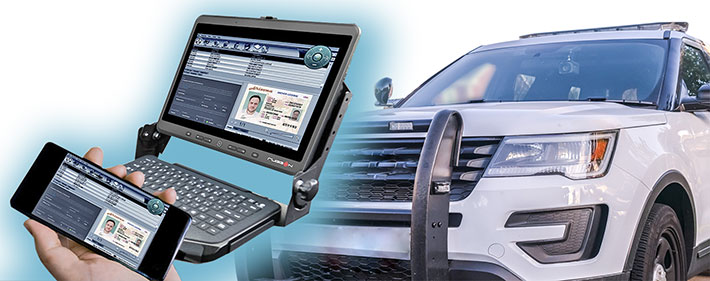
RuggON aims to fix that with the CHASER. How? In essence by bringing the full, productivity-enhancing desktop experience into the vehicle. On-duty officers can connect their smartphones to the CHASER monitor through a USB Type C port for a full desktop experience on a large touch display, and even a mouse and keyboard if desired. Or they can plug their tablet into the CHASER and use it as a computer. Or both.
As is, police cars, firetrucks, ambulances, utility vehicles and all sorts of other rolling stock usually have rugged laptops mounted inside. That works well, but in an April 2021 release, VDC Research suggested that "here is growing potential to disrupt this dynamic with a smartphone replacing the PC as the compute hub and using screen mirroring solutions to duplicate the PC experience on an external display/keyboard. VDC went on to say that such an approach would have cost benefits over traditional mounted PC solutions as well as offering user greater portability. The key challenge, VDC said, would be in applications and compatibility.
Smartphone as the compute hub
Compatibility, of course, is both on the hardware and software side. It's traditionally been difficult to get handhelds, be it phones or small computers, to easily connect to larger computers such as laptops and desktops.  For the most part this required synching, an uneasy process that hardly ever worked very well. None other than pen computing visionary and Palm Pilot founder Jeff Hawkins tried to address the issue in 2007 with the Palm Foleo, a Linux-based small notebook computer with a companion Palm Treo smartphone. That didn't work out. These days, most of the synchronizing happens in the cloud via services by the likes of Google and Apple. That has its pros and cons, and it likely isn't a great solution for the road.
For the most part this required synching, an uneasy process that hardly ever worked very well. None other than pen computing visionary and Palm Pilot founder Jeff Hawkins tried to address the issue in 2007 with the Palm Foleo, a Linux-based small notebook computer with a companion Palm Treo smartphone. That didn't work out. These days, most of the synchronizing happens in the cloud via services by the likes of Google and Apple. That has its pros and cons, and it likely isn't a great solution for the road.
Samsung DeX
So RuggON went another way. They are using Samsung DeX. Samsung DeX — which stands for Desktop experience — is a feature that allows Samsung Galaxy and Note smartphones as well as Samsung Tab tablets act like desktop PCs with a connected monitor, mouse and keyboard. Once connected, the smartphone or tablet be used as a touchpad while leaving all of the device's own functionality available.
But why use a standard linked to a specific brand, even one as big as Samsung? Because Samsung pretty much has enough critical mass to make this feasible. Samsung has about 20% global marketshare in smartphones, which translates into about 270 million phones a year. That's more than all PCs or all tablets sold in a year.
Overall, while we may not as of yet live in a fully "post-PC" world, our lives — professional as well as personal — are no longer as PC-centric as they once were. While laptops haven't replaced desktops they've made inroads, as have tablets. Almost everyone has a smartphone, but are smartphones really replacing the PC as the compute hub as VDC suggests? Perhaps not just yet and maybe never, but screen mirroring solutions that provide a larger-screen PC experience may well boost productivity. And that's what RuggON has in mind with the CHASER monitor platform.
RuggON CHASER usage scenarios
Here are the two primary functions RuggON had in mind when creating the CHASER:
- CHASER can mirror or extend the functionality of smartphones by giving them a much larger desktop-like screen. Simply plug the smartphone into CHASER with a USB Type-C cable. Capacitive touch is fully supported.
- CHASER can also mirror or extend the functionality of PCs such as RuggON's own rugged PX501 Series tablets. RuggON's DashON utility allows for quick changes of display modes (either mirror or extend). Connection is again via HDMI and USB, and CHASER offers full touch functionality.
The images below shows a test setup with both a Samsung Note smartphone and a RuggON PX501 tablet connected to a VESA-mounted CHASER monitor. On the left, the CHASER displays the phones apps screen, in the center it shows the phone's desktop reminiscent of a desktop PC, and on the right the display mode has been switched to the connected tablet.

Note that there is external keyboard and mouse support in every mode. This could be via wired USB connection or, as in our setup, via a wireless Bluetooth adapter.
As for specific scenarios, envision the following:
CHASER and smartphone
In this scenario, a CHASER monitor is mounted in the vehicle, perhaps in conjunction with a keyboard on a keyboard tray. The DeX enabled smartphone is the primary compute hub, using its native apps and whatever third party and custom apps are required for the job. Once connected to the CHASER via USB Type-C cable, the CHASER monitor can either duplicate the smartphone screen or launch the DeX desktop that looks much like the desktop on a Windows PC or a Mac. Unlike on a smartphone where apps generally use the whole screen and you can only use one at a time, on the DeX desktop multiple apps can be opened and used, all in their own resizable windows.
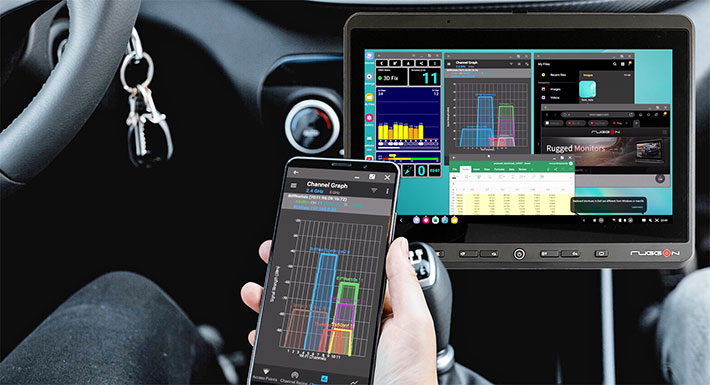
Shown below is 1) the CHASER connected to the smartphone with the DeX desktop showing, 2) the CHASER duplicating the smartphone screen, 3) multiple Android apps running on the CHASER while the smartphone is used for something else, and 4) using the CHASER as a much larger screen for the phone, one that allows the same multi-touch operations as on the phone.

CHASER, smartphone, and tablet PC
Here, a CHASER monitor is again mounted in the vehicle, perhaps in conjunction with a keyboard on a keyboard tray and perhaps also wit a mouse. Both the DeX enabled smartphone and a tablet PC are used on the job. The smartphone connects via a USB Type-C cable, the Windows tablet via an HDMI cable and, if the user wants to control the Windows tablet from the CHASER via touch, also with a USB cable. The user can then switch back and forth between smartphone and tablet, as well as between screen duplication and extended screen or DeX desktop.
Shown below 1) the CHASER duplicating the tablet desktop, 2) using the DashON utility to set the attached CHASER screen into different secondary display modes, and 3) the tablet using the CHASER as an extended screen.

CHASER as office hub
A CHASER monitor can be set up as the center of an office workstation, complete with a standard size keyboard, a mouse and other desired or required peripherals. Field personnel can stop by and connect either their smartphone or their tablet or both. When connecting their smartphone, they can take advantage of the large DeX desktop with access to multiple apps simultaneously while, at the same time, having full use of the phone. When connecting their tablet, they have the benefit of a larger screen (or a secondary screen), a standard keyboard and mouse, access to peripherals, as well as access to other peripherals.
CHASER as real-time vehicle workstation
Mobile applications that require real-time in-vehicle may connect a fixed-mounted industrial box PC connected to the CHASER and use it as a touch display. In addition, operators can still use the CHASER with their DeX enabled smartphone, switching back and forth.
Additional CHASER interface scenarios
RuggON can help customers connect CHASER to other computing devices and peripherals via custom interface connectors.
Below is a screenshot of a Samsung DeX desktop with multiple Android apps running on the CHASER.
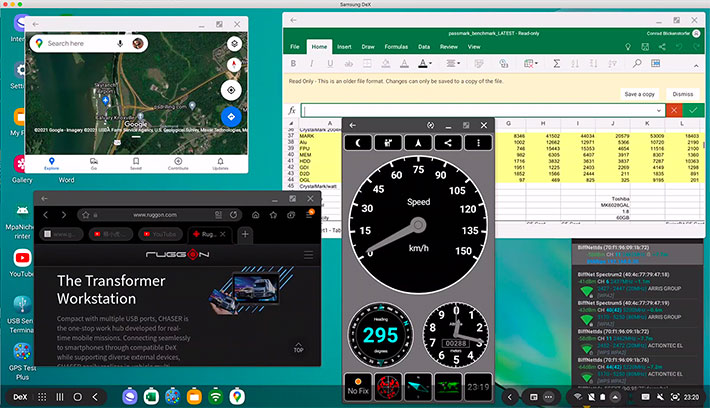
Taking a closer look at the RuggON CHASER
In essence a special purpose rugged monitor, the 11.6-inch CHASER PCAP touch monitor was conceived as a mobile and multifunctional workstation for public safety and similar types of vehicles. That meant generous I/O for versatile connectivity as well as simple, user-friendly operation. The very bright sunlight-readable display is available with anti-reflective coating for an optimal viewing experience, reduced eye strain and a comfortable, productive workflow. The monitor is also equipped with two 3 watt speakers powerful enough to be be heard even in noisy environments.
The CHASER measures 11.65 x 8.5 x 1.7 inches and weighs about four pounds. Below is a look at the CHASER from the front and from all four sides:
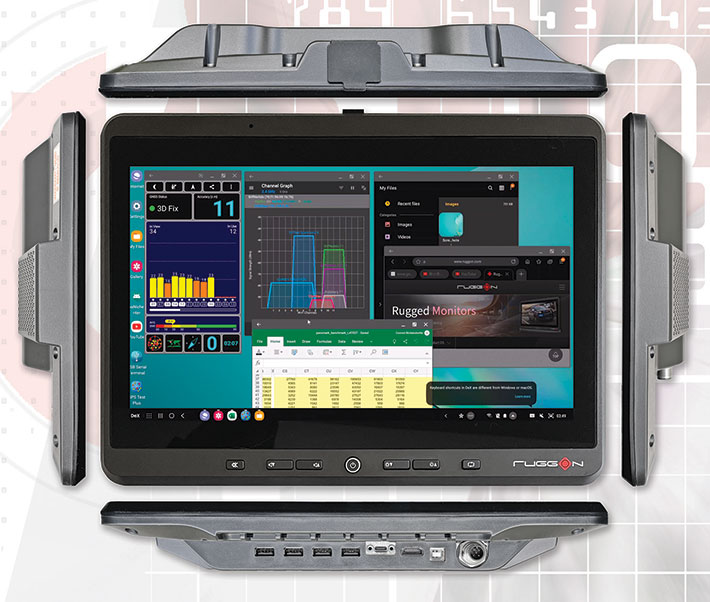
On the left and right sides are the CHASER's speakers. All other I/O and ports are facing down. The image below shows a close-up of all those ports.


The RuggON CHASER provides the following onboard I/O, from left to right:
- 4 x USB 2.0 Type-A ports to connect devices
- 1 x USB 2.0 Type-C with DisplayPort support for connecting smartphones and other Type-C devices.
- 1 x HDMI 1.4 to connect HDMI sources to the CHASER
- 1 x USB 2.0 Type-B to enable CHASER touch functionality
- 1 x Industrial screw-on power connector for 9 to 36 VDC
The CHASER is designed to eliminate accidental cable disconnects and also to minimize cable entanglement for safe operation and a neat cabin. The display backlight and indicator lights can be turned off via a black-out button to minimize driver distraction or safeguard information. VESA 75 pattern screw holes and smart-lock brackets make for easy and secure mounting anywhere.
Below a look at one of the many ways a CHASER can be mounted in a cabin, here with a third party keyboard tray:
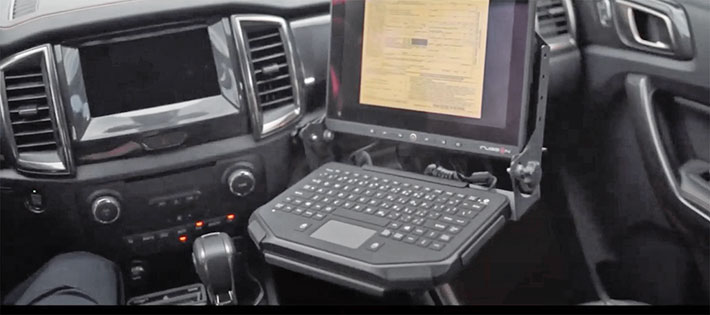
Ergonomic design, durable construction
Most RuggON CHASER monitors will be used in vehicles. That means plenty of bumps and vibration. The device needs to be able to stand up to that. The body of the CHASER consists of a front and a back half, both made of black PC polycarbonate polymer.  No fewer than 20 Torx T8 screws hold the two halves together. The halves are sealed with a tongue-and-groove design with a white silicon o-ring sitting in the groove.
No fewer than 20 Torx T8 screws hold the two halves together. The halves are sealed with a tongue-and-groove design with a white silicon o-ring sitting in the groove.
The entire housing design of the CHASER is functional to the max. As is almost always the case in vehicle-mounts, all I/O ports (except a single additional USB port on top) are facing down so that cables don't get in the way. Every port is clearly marked and labeled in white on black.
For more permanent installation of cables, there are brackets that hold a cable in place, and those brackets are adjustable so that the plug will not come loose under any circumstances. But wait, there's more. Just to make extra sure that cables aren't ripped out of the device by mistake, there are also strain relief anchors in the housing. Each cable can be zip-tied to its anchor. Talk about attention to detail.
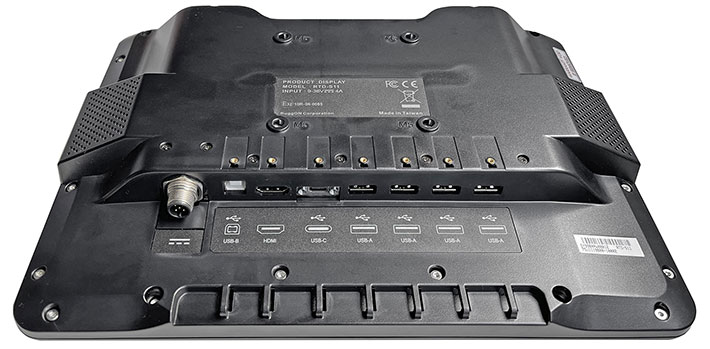
Once all 20 screws have been removed, the two halves come apart and there are no ribbon cables or other wires between the halves. Below you can see what the CHASER looks like inside.
The back side (left) doesn't contain any electronics. Note the the steel reinforcement plate that adds extra strength to the VESA 75 screw mounting pattern. Also note that the reinforcement bracket also serves as a cooling sink for one of the CHASER's system board chips.
The front part of the housing (right) holds the system board, speakers, power converter and I/O face. The LCD is mounted into the device from the front. As we've come to expect from RuggON, everything is neatly labeled, neatly marked and neatly organized. Note the white silicon that holds all the electrolytic capacitors securely in place. All of this matters in a vehicle-mount.

Below you can see some of the many interesting details of the CHASER. From left to right, the steel mounting reinforcement plate that also serves as a heat spreader, the tongue-and-groove seal with the white o-ring, the precision- and shock-mounted speakers that are mounted at angles for optimal stereo effect, and finally a closer look at the silicone-secured capacitors..

Since there is no RAM, storage, or modular expansion in a monitor, most users will never take their CHASER units apart. We here at RuggedPCReview do, because we want to know and show our readers what products look like inside amnd how well they are made.
Bright, pleasant display
A good display is crucial in any computer, and especially so in a vehicle mount system that will be used in rapidly changing lighting conditions, from dim or dark all the way to bright sunlight. That requires a display that can handle those conditions, as well as all the physical abuse inherent to vehicle mounts.
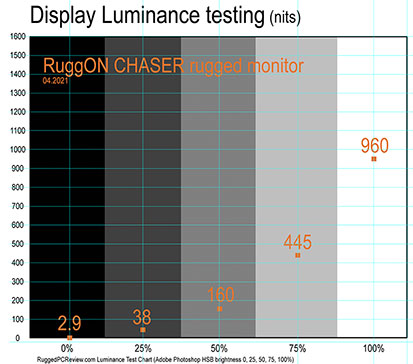 How did RuggON address the display issue? With an industrial-grade 11.6-inch 1920 x 1080 pixel LCD, which makes for 190 pixels per inch.
How did RuggON address the display issue? With an industrial-grade 11.6-inch 1920 x 1080 pixel LCD, which makes for 190 pixels per inch.
That pixel density is way less than that in modern smartphones. The Galaxy Samsung Note 10+ RuggON sent of for evaluation with the CHASER sports 3040 x 1440 pixel resolution on its much smaller 6.8-inch screen — almost 500 ppi — but optimal PPI differs with the size of a display. 190 ppi is plenty sharp for a vehicle monitor (almost as sharp as an iMac27 5k retina display).
RuggON knows the importance of vehicle computer displays being bright enough so that they can easily be viewed under all possible lighting conditions. For that reason, the CHASER comes with just one display option, a very 1,000 nits version. In our own luminance testing we found 960 nits, the slight difference probably due to the anti-reflective and anti-fingerprint coatings. Less luminance would have been okay most of the time inside an enclosed vehicle, but offering enough brightness for ANY condition is definitely the way to go.
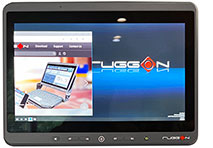 CHASER display brightness can be manually adjusted via hardware buttons. While the display is of the glossy kind like most contemporary phones, tablets and laptops, it has better than average anti-reflective treatment.
CHASER display brightness can be manually adjusted via hardware buttons. While the display is of the glossy kind like most contemporary phones, tablets and laptops, it has better than average anti-reflective treatment.
Unlike so many consumer notebooks and tablets that become unreadable either due to weak backlights or insufficient reflection control, the CHASER remains readable under almost any condition. Viewing angles are 85 degree from all directions, near perfect.
As far as touch goes, the CHASER offers the same responsive capacitive multi-touch experience everyone has come to expect from modern smartphones and tablets. Operation is quick and and precise, the display surface offers just the right feedback to fingers, and the flush half-inch bezel area means fingers won't bop into a display border.
Ruggedness
A vehicle-mount computer's ruggedness characteristics are inherently different from those of a rugged mobile system. Vehicle-mounts aren't generally carried around and thus won't be dropped. So the drop spec that's so important in hand-carried mobile devices isn't an issue. 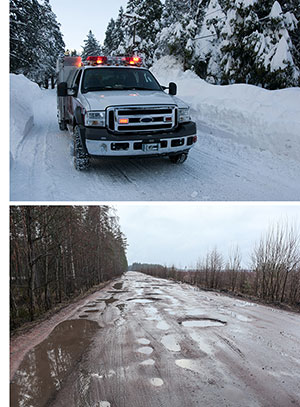 Vehicle-mounts, on the other hand, are exposed to much more vibration and shock. And temperature resistance is important because, depending on the mounting location, it can get very hot or cold inside vehicle.
Vehicle-mounts, on the other hand, are exposed to much more vibration and shock. And temperature resistance is important because, depending on the mounting location, it can get very hot or cold inside vehicle.
As far as available environmental specs of the RuggON CHASER goes, the device has an very wide operating temperature range of -4 to 140 degrees Fahrenheit (-20 to 60 degrees Celsius). Since CHASER units are designed to be used indoors or in vehicles, this should cover just about any temperature usage scenario.
RuggON doesn't state an ingress protection rating for the CHASER, again because CHASER units won't likely be used outdoors where they are exposed to the elements. As is, the CHASER's front panel is waterproof, so it can easily be cleaned or even washed down.
Shock and vibration resistance is extremely important in vehicle electronics. Here, RuggON refers to the CHASER passing MIL-STD-810H testing, but not to specifics. We assume that the CHASER was subjected to the same testing as RuggON's vehicle-mount computers (such as the VIULCAN X), which would mean passing the MIL-STD-810H, Method 514.8 C2/C4/C6 procedures that describe vibration exposure testing for US highway trucks in C2 and, more importantly, composite two-wheeled trailer vibration exposure in C4, and composite wheeled vibration exposure in C6.
The images below show some of the testing equipment in RuggON's inhouse ruggedness testing facilities.

Since ruggedness testing results can be extensive, manufacturers usually only include highlights into their tech specs. We recommend to always request all available ruggedness testing results, especially as they pertain to planned deployment of a device.
The RuggON CHASER rugged monitor: bottom line
With the CHASER rugged touch monitor, RuggON seeks to serve a new mobile computing paradigm that includes the by now ubiquitous smartphone. Everyone has one, and smartphones are increasingly used on the job. So instead of keeping smartphones and the more traditional tablets and laptops separate, the CHASER monitor serves as a common hub, one where the smartphone has its own desktop and apps run in windows.  It does that by having dual video inputs as well as enough ports to accommodate supporting peripherals. Users can then, for example, switch back and forth between their smartphone and a tablet or real-time applications running on onboard industrial box PC. In essence, the CHASER provides an office-like desktop environment in a vehicle.
It does that by having dual video inputs as well as enough ports to accommodate supporting peripherals. Users can then, for example, switch back and forth between their smartphone and a tablet or real-time applications running on onboard industrial box PC. In essence, the CHASER provides an office-like desktop environment in a vehicle.
The CHASER's 11.6" full HD display provides more screen real estate to work on than standard tablet PCs, and a lot more than any smartphone. The CHASER also provides full multi-touch functionality for attached devices. The strong 1,000 nits luminance backlight easily allows the unit to be used in all lighting conditions. The glossy display offers good reflection control and near perfect viewing angles from all directions.
When using the CHASER in conjunction with a rugged tablet such as RuggON's own PX501B, the tablet's DashON utility allows for one-touch selection of mirror or screen extension display modes. Used with a smartphone, the phone screen can be mirrored or phone apps are displayed, and can be used, on a PC-like desktop. While doing the latter, the phone itself can be used for other functions.
One caveat is that smartphone integration is using Samsung DeX (Desktop eXtension), which is only available on recent Samsung phones. Even with Samsung's large smartphone marketshare, that may or may not be an issue. -- Conrad H. Blickenstorfer, June 2021
Specifications RuggON CHASER
| Added/changed |
Full review 05/2021
|
| Display type |
LED-backlit TFT, 1000 nits, wide viewing angle (85/85/85/85 degrees |
| Display size/resolution |
11.6-inch Full HD 1920 x 1080 pixel (190ppi) |
| Digitizer |
Projected capacitive touchscreen with 10-point multi-touch |
| Buttons |
Black out, mute, volume up/down, brightness up/down, video input select
|
| Navigation |
Touch, mouse
|
| Housing |
PC + ABS polymer with reinforced VESA 75 screw pattern
|
| Size |
11.65 x 9.21 x 1.71 inches (296 x 216 x 43.5 mm)
|
| Weight |
3.97 lbs (1.8kg)
|
| Operating temperature |
-4° to 140°F (-20° to 60°C) in accordance with MIL-STD-810H 501.7 High Temperature Procedure II and MIL-STD-810H 502.7 Low Temperature Procedure II
|
| Ingress protection |
Waterproof front panel |
| Humidity |
5 to 95% non-condensing |
| Shock |
MIL-STD-810H |
| Vibration |
MIL-STD-810H |
| Altitude |
Unknown |
| Power |
9~36V VDC, max 4A (12V nominal) |
| Certifications |
CE, FCC Class B, E-Mark |
| Interface |
1 x USB 2.0 Type-C (DisplayPort supported)
5 x USB 2.0 type A
1 x USB 2.0 type B
1 x HDMI 1.4
1 x DC-in
|
| Price |
Inquire |
| Spec sheet |
 RuggON CHASER brochure (PDF) RuggON CHASER brochure (PDF)
|
| Web page |
RuggON CHASER web page |
| Contact |
 RuggON Corporation
RuggON Corporation
4F., No. 298, Yang Guang St., NeiHu Dist.
Taipei City 11491, Taiwan
Telephone: 886-2-8797-1778
Fax: 886-2-8797-1881
Web: www.ruggon.com
info@ruggon.com
|





 For the most part this required synching, an uneasy process that hardly ever worked very well. None other than pen computing visionary and Palm Pilot founder Jeff Hawkins tried to address the issue in 2007 with the Palm Foleo, a Linux-based small notebook computer with a companion Palm Treo smartphone. That didn't work out. These days, most of the synchronizing happens in the cloud via services by the likes of Google and Apple. That has its pros and cons, and it likely isn't a great solution for the road.
For the most part this required synching, an uneasy process that hardly ever worked very well. None other than pen computing visionary and Palm Pilot founder Jeff Hawkins tried to address the issue in 2007 with the Palm Foleo, a Linux-based small notebook computer with a companion Palm Treo smartphone. That didn't work out. These days, most of the synchronizing happens in the cloud via services by the likes of Google and Apple. That has its pros and cons, and it likely isn't a great solution for the road.










 No fewer than 20 Torx T8 screws hold the two halves together. The halves are sealed with a tongue-and-groove design with a white silicon o-ring sitting in the groove.
No fewer than 20 Torx T8 screws hold the two halves together. The halves are sealed with a tongue-and-groove design with a white silicon o-ring sitting in the groove.



 How did RuggON address the display issue? With an industrial-grade 11.6-inch 1920 x 1080 pixel LCD, which makes for 190 pixels per inch.
How did RuggON address the display issue? With an industrial-grade 11.6-inch 1920 x 1080 pixel LCD, which makes for 190 pixels per inch.
 CHASER display brightness can be manually adjusted via hardware buttons. While the display is of the glossy kind like most contemporary phones, tablets and laptops, it has better than average anti-reflective treatment.
CHASER display brightness can be manually adjusted via hardware buttons. While the display is of the glossy kind like most contemporary phones, tablets and laptops, it has better than average anti-reflective treatment.
 Vehicle-mounts, on the other hand, are exposed to much more vibration and shock. And temperature resistance is important because, depending on the mounting location, it can get very hot or cold inside vehicle.
Vehicle-mounts, on the other hand, are exposed to much more vibration and shock. And temperature resistance is important because, depending on the mounting location, it can get very hot or cold inside vehicle.

 It does that by having dual video inputs as well as enough ports to accommodate supporting peripherals. Users can then, for example, switch back and forth between their smartphone and a tablet or real-time applications running on onboard industrial box PC. In essence, the CHASER provides an office-like desktop environment in a vehicle.
It does that by having dual video inputs as well as enough ports to accommodate supporting peripherals. Users can then, for example, switch back and forth between their smartphone and a tablet or real-time applications running on onboard industrial box PC. In essence, the CHASER provides an office-like desktop environment in a vehicle.

 RuggON Corporation
RuggON Corporation